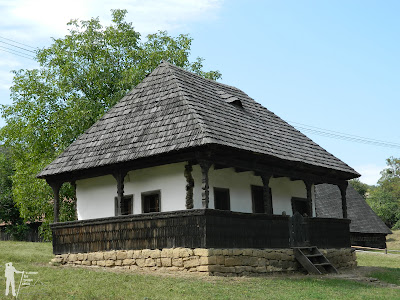Parcul Etnografic Naţional „Romulus Vuia” este
mai cunoscut de Clujeni sub numele generic „Parcul din Hoia”, după numele
colinei unde se află. Parcul e la marginea oraşului şi l-am căutat insistent
pentru a-l vizita. În drum am trecut şi pe lângă stadionul CFR Cluj.
Dacă Muzeul Satului din Bucureşti este
ticsit şi nu mai e loc să dai drumul unui ac, la Cluj e loc berechet – muzeul
şi-ar putea uşor tripla achiziţiile. Deocamdată muzeul arată ca o suită de 2-3
sate, casele fiind strânse mănunchi în jurul unei biserici de lemn, cum se găsesc
în Maramureş sau în Sălaj.
Vizita s-a făcut cu ghid. Într-o oră am
trecut prin toată Transilvania şi am văzut atât case moţeşti cât şi gospodării săseşti
sau secuieşti. Ghida ne-a povestit câte ceva despre fiecare, detaliind
specificităţi regionale. Totuşi, mă întreb de ce nu se face vizita la liber, ca
la Bucureşti, unde e o forfotă de nedescris în muzeu (nu am întrebat). E adevărat că vremea era caniculară.
Plăcuţe
multilingve ar fi de dorit, care să descrie succint fiecare obiectiv. Acest
consideraţiuni nu m-au împiedicat să mă bucur din plin de frumuseţea muzeului, cu toată varietatea sa, din regiunea Maramureşului în Apuseni, de la case săseşti cu mobilier pictat la gospodării secuieşti cu porţi înalte de lemn.
The National Ethnographic Parc "Romulus Vuia" in Cluj (Hoia)
The National Ethnographic Parc "Romulus Vuia" in Cluj is also known as the park in Hoia, because it is found on a hill at the edge of the city. Looking for it, we also drove by the stadium of Champions League participants CFR Cluj.
If the Village Museum in Bucharest is packed with traditional buildings and you could not drop a needle there anymore, in Cluj there is plenty of room to expand the museum several times over. The houses are bundled together around wooden churches from Maramureş or Sălaj, just like real villages are, in 2 or three clusters, with plenty of space around them.
We took the guided tour. There seemed to be no free visit, which is odd, because that's the system in Bucharest and the museum is bustling with people. In Cluj there was just another small group, odd, even though the heat might also be an explanation.
Even though the guide told us a lot of interesting facts about the houses, multilingual plaques, like in Bucharest, would be helpful so that tourists would have a certain autonomy. There are plenty of interesting facts to find out about the vast variety of dwellings and churches of Transylvania, from the Maramureş to the Apuseni Mountains, down to the Saxon region and its painted furniture or to the eastern mountains and Hungarian houses and wooden gates.


































Tot in zona se intinde si Padurea Hoia Baciu, un loc in care se spune ca ar exista un fel energii neobisnuite, datorita carora copacii s-au dezvoltat intr-un mod foarte ciudat, avand chiar un aspect infricosator
RăspundețiȘtergereInteresant. La o scurtă căutare pe internet am găsit imagini foarte interesante. Mulțumesc!
RăspundețiȘtergere